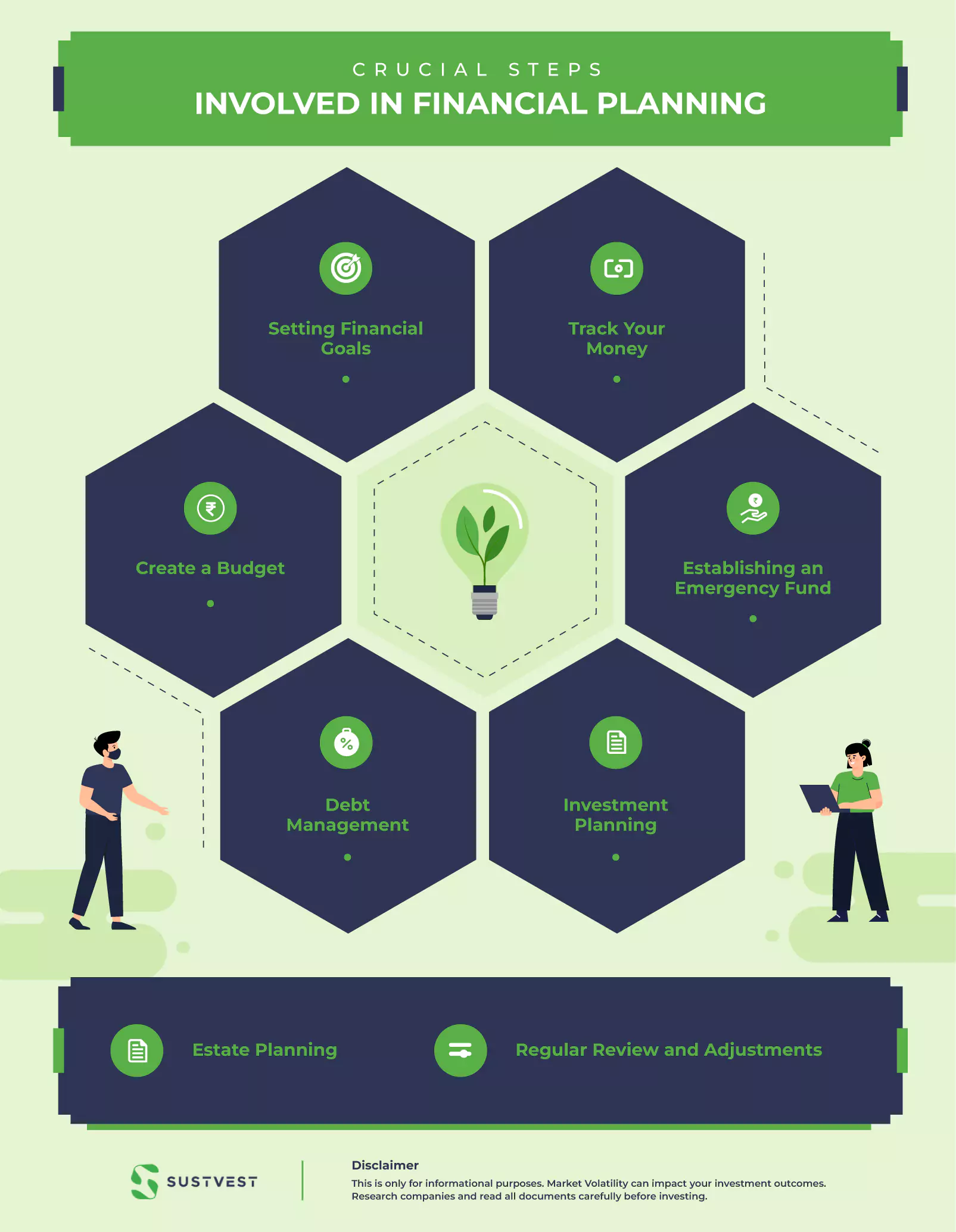Ever dreamed of being in the driver’s seat of your financial destiny?
Imagine a life where every financial choice you make is clear, confident, and rewarding. That’s the power of understanding the steps involved in financial planning.
You see, it’s about more than saving money or making the right investments. It’s about aligning those actions with your life’s ambitions, both big and small.
By mastering these steps, you’re essentially drawing a map to your financial independence, making sure each decision moves you closer to your dream destination.
Dive in with us as we unravel these steps, simplifying them so you can take action.
Ready to embark on the road to financial freedom?

Crucial Steps Involved In Financial Planning
Financial planning helps people manage their money, reach their goals, and protect their financial future. The steps involved in financial planning provide a structured approach to ensure sound financial decisions.
Here are the key steps:
1. Setting Financial Goals
Defining clear short-term and long-term financial objectives is the first step in effective financial planning. These goals provide direction and purpose to your financial decisions.
Whether it’s buying a home, saving for education, or achieving a comfortable retirement, articulating your aspirations helps you allocate resources appropriately and track your progress.
Well-defined financial goals serve as a roadmap, guiding your financial planning journey toward success and ensuring that your efforts remain focused on achieving desired outcomes.
2. Track Your Money
Understanding your monthly cash flow—incoming and outgoing—is fundamental for effective financial planning. This insight serves as the foundation for creating a financial strategy, allowing you to channel more funds towards savings or debt reduction.
By comprehending your spending patterns, you can formulate short, medium, and long-term plans.
For instance, an immediate plan might involve crafting a budget. We recommend a 50/30/20 budget allocation of 50% to needs, 30% to wants, and 20% to savings and debt repayment. Medium-term plans often target high-interest debt reduction, while long-term plans revolve around retirement preparation.
3. Create a Budget
Creating a budget involves outlining your anticipated income and expenses to manage your finances effectively.
Start by listing all sources of income, including your salary and other earnings.
Next, divide your expenses into necessities (housing, utilities, groceries), savings (for goals and emergencies), investments, and discretionary spending.
To avoid overspending, subtract expenses from income. As needed, allocate funds to each area and balance consumption and saving.
To create a budget, follow these easy tips:
- List all income sources.
- Categorize expenses: essentials, savings, investments, discretionary.
- Calculate total expenses and subtract from income.
- Adjust spending to ensure a balanced budget.
- Review and update the budget regularly to stay on track.
4. Establishing an Emergency Fund
An emergency fund acts as a financial safety net for unforeseen circumstances. It involves setting aside a dedicated amount of money, typically equivalent to 3-6 months’ worth of living expenses.
This fund provides a buffer to cover unexpected events like medical emergencies, job loss, or major repairs without derailing your financial stability.
By having quick access to these funds, you avoid resorting to high-interest loans or disrupting long-term investments.
An emergency fund not only offers peace of mind but also safeguards your overall financial health by ensuring you’re prepared to handle life’s unexpected challenges without derailing your financial progress.
5. Debt Management
The management of debt is of utmost importance due to its significant impact on one’s financial stability and future possibilities.
Efficient debt management strategies serve to mitigate the rise of debt, safeguard one’s credit rating, and allocate resources towards the achievement of additional financial objectives.
The following is a guide on effectively managing debt:
- Assessment: List all debts, including interest rates and terms.
- Prioritization: Focus on high-interest debts first to minimize overall interest payments.
- Budgeting: Allocate extra funds towards debt repayment in your budget.
- Consolidation: Consider consolidating multiple debts into a single, lower-interest loan.
- Negotiation: Contact creditors to negotiate better terms or settlements.
- Lifestyle Adjustments: Temporarily cut non-essential expenses to channel more funds towards debt.
- Avoid New Debt: Minimize using credit cards or taking new loans during debt repayment.
By adhering to these strategies, you can regain control over your financial situation, reduce debt burdens, and work towards a healthier financial future.
6. Investment Planning
Investment planning involves strategically allocating your funds to various assets like stocks, bonds, and real estate to achieve long-term financial growth.
Assess your willingness to take risks and your investment goals. Diversify your portfolio to spread risk and potentially increase returns. Regularly monitor and adjust investments as market conditions change.
By harnessing the power of compounding and staying informed about market trends, investment planning can help you build wealth over time and work towards achieving your financial aspirations.
Yet, while you chart out your investment journey, it’s vital to know How to Make a Successful Long Term Investment Decision (2023)?
7. Plan for Retirement
Planning for retirement in India involves preparing financially for your post-work years. Estimate the income you’ll need during retirement based on your lifestyle preferences. Contribute to retirement-specific investment avenues to build a retirement corpus.
These retirement plans are:
- Employees’ Provident Fund (EPF)
- Public Provident Fund (PPF)
- National Pension System (NPS)
Consider tax implications and choose investments aligned with your risk tolerance and time horizon. Regularly review your retirement plan and adjust contributions as needed.
With increasing life expectancy, early and consistent retirement planning is crucial to ensure a comfortable and stress-free retirement in India.
As you chalk out your retirement pathway, it’s worth exploring Securing a Peaceful Retirement: The Best Senior Citizen Savings and Monthly Income Schemes.
8. Insurance Coverage
Insurance protects against unexpected costs and accidents. It’s like a backup. Health, life, and house and vehicle insurance assist in covering medical bills, providing money to your family, and repairing the damage.
Having the correct insurance helps you avoid major financial issues when unfortunate things happen.
In India, there are various types of insurance available to safeguard against different risks:
- Life Insurance: Provides money to your family if you pass away.
- Health Insurance: Covers medical expenses if you get sick or hurt.
- Motor Insurance: Protects your vehicle from accidents and damage.
- Home Insurance: Helps repair or replace your home and belongings after events like fires or theft.
- Travel Insurance: Covers unexpected problems during trips, like cancelled flights or medical emergencies.
- Term Insurance: Offers a large sum of money to your family if you die during a specific time.
- Investment-Linked Insurance: Combines life insurance with investments to grow your money over time.
Each type of insurance serves a specific purpose and helps you manage risks better.
9. Estate Planning
Estate planning involves preparing for the distribution of your assets after your passing. It encompasses creating a legally binding will to detail how your assets should be divided among beneficiaries.
Establishing trusts can offer added control and privacy, particularly for complex estates. Naming beneficiaries for retirement accounts, life insurance policies, and other assets ensures a smooth transition.
Estate planning minimises potential conflicts, reduces tax liabilities, and ensures your wishes are honored, providing both financial security and peace of mind for your loved ones in times of emotional difficulty.
Regular updates to your plan are essential to reflect changing circumstances and laws.
10. Regular Review and Adjustments
Financial planning is not a one-time task; it requires ongoing attention. Periodically review your financial plan to accommodate changes in your life, goals, and economic conditions.
Life events like marriage, having children, or career shifts may necessitate adjustments. Likewise, economic fluctuations can impact investments and goals.
By regularly revisiting your plan, you ensure its relevance and effectiveness, making necessary modifications to stay on track and optimize your financial journey.

FAQS
What are the initial steps in financial planning?
Begin by setting clear financial goals and assessing your current financial situation, including income, expenses, and assets.
How does budgeting contribute to financial planning?
Budgeting allocates funds for different needs, helping you manage expenses, save for goals, and avoid overspending.
How does goal setting impact financial planning?
Goal setting provides a clear direction, helping you prioritize savings, investments, and expenses aligned with your objectives, whether it’s buying a home or retiring comfortably.
Why is risk assessment important in financial planning?
Evaluating risks associated with investments and unforeseen events aids in creating a resilient financial plan that can adapt to changing circumstances.
What role does periodic review play in financial planning?
Regularly reviewing your financial plan allows you to track progress, make necessary adjustments, and ensure alignment with your goals.
To Sum Up
In essence, the steps involved in financial planning serve as a comprehensive guide to achieving monetary stability and future aspirations.
Through goal setting, budgeting, investment strategies, risk assessment, and periodic review, individuals can navigate the complex landscape of personal finance.
By embracing these steps, individuals can pave the way for informed decisions and a secure financial future. Ready to take control of your financial destiny?
Embarking on this financial freedom? The burning question remains: What is the Best Investment Plan In India In 2023? Insights await.
Start your journey with SustVest, integrating sustainable practices into your financial planning for a prosperous and responsible tomorrow.

Founder of Sustvest
Hardik completed his B.Tech from BITS Pilani. Keeping the current global scenario, the growth of renewable energy in mind, and people looking for investment opportunities in mind he founded SustVest ( formerly, Solar Grid X ) in 2018. This venture led him to achieve the ‘Emerging Fintech Talent of the Year in MENA region ‘ in October 2019.




